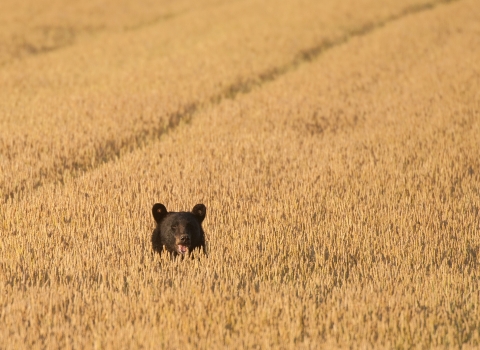Some migratory shorebirds fly long distances. We mean really, really long distances. Shorebirds can fly from as far away as South America to the northern end of Alaska in the summer and back again during the winter on a pathway known as the Pacific Flyway.
But where do birds fly? How do we know where they stop, what they eat, and who their predators may be?
We track them.
Learn more at the related storymap: Motus: Revolutionizing Data Collection, One Bird at a Time
The Motus Wildlife Tracking System is an international collaborative research network of automated radio telemetry receiving stations. Motus, which is Latin for movement, tracks insects, birds, bats, and other animals over the landscape using radio technology. It's just one of the tools that biologists, conservationists, and others use to monitor wildlife.
Motus transmitters can be made so small and light that they can be placed on and used to track small birds, bats, and even large insects. These transmitters emit individually unique, digitally encoded radio signals that broadcast up to several times each minute. The radio signals contain information about how a specific animal is using a particular habitat and their arrival, departure, and length of stay at key stopover points.
Radio signals are detected by receiving stations that continuously scan for these signals. When results from many stations are combined, the array can track animals across a diversity of landscapes covering thousands of miles. Signals from these tiny transmitters can travel up to about 10 miles.
Motus transmitters are so small that they provide a one-of-a-kind opportunity to track a wide variety of small animals possible at different geographic scales. Since 2013, more than 10,000 individuals of over 100 species have been monitored using Motus. Data collected from these stations feed into Bird Studies Canada's master database where they are archived, visualized, and distributed to researchers and the general public.
“There are a few major advantages to Motus,” U.S. Fish and Wildlife Service wildlife biologist Vanessa Loverti said. “One of them is that the size of the transmitters is small enough to use on smaller shorebirds like western sandpipers versus satellite telemetry that we use on bigger birds to track migration. Second, the cost of putting up a Motus tower is much more feasible for our partners and uses a collaborative research network for avian conservation, which provides valuable information like length-of-stay, timing of migration to the breeding ground, and data on unpredicted stopover sites.”
Within the last five years, 17 Motus towers, including one at Grays Harbor National Wildlife Refuge, have gone up in Oregon and Washington. These towers providing researchers with valuable data on bird movements in the Pacific Flyway.
Motus at Ankeny: A Willamette Valley Data Tap and Public App
Rich Schramm knows about long distances.
Schramm, a volunteer at the Ankeny Hill Nature Center at Ankeny National Wildlife Refuge, worked at the Monterey Bay Aquarium Research Institute before he retired. With a background in instrumentation and data management, Schramm understands the challenges of tracking animals—in his case, marine life—over time and distance. During his career, Schramm watched as evolving technology allowed marine biologists to make huge leaps in understanding the movement of animals. When Schramm heard about Motus, he knew he wanted to help, especially in making it easier for the public to understand what makes the Motus data so exciting.
“You can go to the Motus website, but it takes time to understand the Motus system before you can easily see what is happening locally and how it relates to the bigger story,” Schramm said. “We wanted something that’s more user friendly, something that both a precocious kid and their grandparent could use.”
Ankeny National Wildlife Refuge is nestled near the confluence of the Santiam and Willamette Rivers in the middle of the Willamette Valley. The area was previously known as "Ankeny Bottoms" and was selected as a refuge site to provide overwintering habitat for the dusky Canada goose and other migratory waterfowl. Today, the refuge provides wetlands and riparian riparian
Definition of riparian habitat or riparian areas.
Learn more about riparian woodland sanctuary for migratory and resident wildlife, which range from the tiny Pacific chorus frog to the black-tailed deer.
The refuge is also home to the Ankeny Hill Nature Center, which opened in 2022 to provide education opportunities about local birds, wildlife, and their habitat. The nature center is the outcome of a rewarding partnership between the Service, the Salem Audubon Society, and Friends of the Willamette Valley National Wildlife Refuge Complex. With an outdoor nature learning area, pollinator garden, overlooks, accessible trails, and educational programming like the monthly bilingual preschool - there is something for everyone at the nature center.
A Motus tower at Ankeny National Wildlife Refuge was erected in October 2022 to help track birds migrating through the Willamette Valley. Data from the tower has already yielded stunning results. In January 2023, the Motus tower picked up signals from American robins that had migrated all the way from Vancouver, Canada. Researchers had previously been unaware that robins traveled that far south. This particular robin went on even further to San Francisco.
“It was really quiet after we first put up the tower,” Schramm said. “We were even wondering if the system was working. But then the robin showed up on January 10th. It spent a week at Ankeny, left, and came back. Just from that hit we’re going to learn a lot about where robins go during their non-breeding period.”
After seeing the richness of the data coming from the Motus tower, Schramm decided to develop an app so members of the public could see it too. He wanted to control the content to make sure it didn’t get corrupted, and he also wanted to make it stand alone so it didn’t require maintenance. After Schramm released the app, he posted the code to GitHub so that anyone can download it for their own use.
The Ankeny Hill Nature Center houses a Motus data terminal where visitors can see real-time tracking information on wildlife. With one touch, you can see the number of times the tower has received a signal from a tagged bird, including where that bird has been and if it flew by other towers along its migration route.
The next step for Rich? More Motus towers means more data, which means more opportunities for conservation.
“We really need to push to get more towers and more tagging,” Schramm said. “It would be great to see schools put Motus towers on their rooftops as an educational opportunity for students. Schools have chess clubs and debate clubs, and I could see them having Motus clubs, too. I hope that hobbyists can put up their own towers. The technology is there. We just need to get the word out.”
It doesn’t take too much to go the distance in bird conservation. If you want to get involved, you can reach out to Ankeny National Wildlife Refuge and ask what you can do to help. You can set up a tower in your backyard or participate in local bird counts or a community science project. Come join and learn with us!





